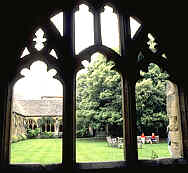

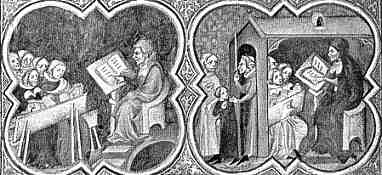
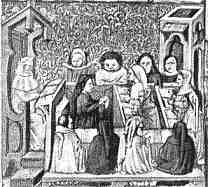
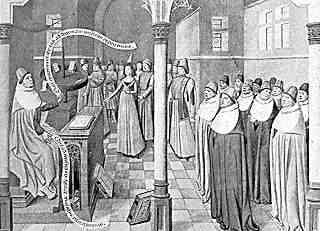
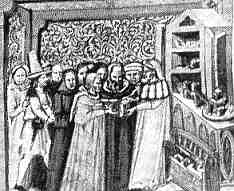
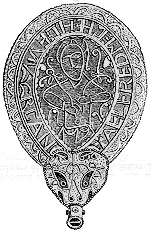
If you are looking at this page without frames, there is more information about medieval writing to be found by going to the home page (framed) or the site map (no frames).
| The Material Culture of Literacy (4) | ||||||
| The teaching of literacy also had its particular architecture and furnishings. | ||||||
 |
Teaching was originally carried out in the monasteries, cathedrals or church schools. The universities were founded specifically to educate members of the clergy, and as the first purpose-built educational institutions, their layout followed that of a monastery or cathedral. The medieval cloisters of New College, Oxford reflect this relationship perfectly. | |||||
| Cloisters of New College, Oxford. | ||||||
| In the later middle ages, grammar schools were set up within local churches. This building within the complex of the collegiate church at Higham Ferrers has evidently served both as a chantry chapel and grammar school. |
 |
|||||
| Grammar school at Higham Ferrers, Northamptonshire. | ||||||
 |
||||||
 |
Above, two images of Nicolas Oresme teaching, from a 14th century set of miniatures in a translation of his Ethics of Aristotle (Bibliothèque de Bruxelles). At left, a teaching scene from a manuscript miniature (Bibliothèque de Cambrai). (From Lanson 1923) | |||||
| The above images of teaching have various features in common. The teacher sits on an imposing, elevated chair with a codex open in front of them on a lectern or reading desk. The students sit in serried ranks at plain reading benches. Each student also has an open copy of the book on the bench in front of them. The teacher in each miniature is pointing to the text in the book. The whole imagery suggests a trickling down of the received text, verbatim. | ||||||
 |
||||||
| Miniature of St Augustine teaching, from a 15th century translation of the City of God by Raoul de Presles (Bibliothèque Nationale). (From Lanson 1923) | ||||||
| In true medieval anachronistic fashion, St Augustine and his pupils are not presented as members of the African intelligentsia of the 4th century, but as late medieval academics. Both teacher and listeners wear the tight skull caps and robes of university academics. Yes, literacy even had a uniform by this time. He sits on an elevated chair with his book in front of him, and a couple of others artfully arranged around the scene. One of those funny circular bookstands sits to his left. The scrolls emanating from his hands are metaphors for his words, rather than literal representations. There is a lady in the group to the left of the speaker, but she seems to be relegated to the cheap seats rather than the front stalls. | ||||||
 |
Of course, if all those students are going to sit in class with a book in front of them, there have to be booksellers. This fellow seems to be running with his sales pitch in front of shelves, display stands and chests of his wares. | |||||
| Miniature of a bookseller in a manuscript from the Bibliothèque de Cambrai. (From Lanson 1923) | ||||||
| To finish off with an enigma going right back to Anglo-Saxon days, there is a unique piece of jeweller's work, known as the Alfred Jewel. | ||||||
 |
This complex gold object, set with rock crystal and cloisonné enamel, has an Old English inscription saying that Alfred caused it to be made. The animal head ornament holds a round socket which is presumed to have held a pointer. It has been interpreted as being a bookmark or pointer, such as King Alfred promised to send to every bishopric in the kingdom, along with a copy of the Old English translation of Gregory the Great's Pastoral Care. The harp playing Dane smiter has been credited with doing the translation himself, but I doubt it. Kings didn't even cut up their own meat. | |||||
| The Alfred Jewel, now in the Ashmolean Museum, Oxford. | ||||||
| Only one other similar object, rather less splendid, has been found. I wonder what happened to the others, or what happened to this one for that matter, considering that it was found in a field. While books themselves could be highly splendid items, expensive reading or writing accessories do not seem to be part of the medieval miscellanea that end up by various means in museums. One exception would seem to be some exquisitely carved little ivory booklets for waxed tablets from around the 14th century. | ||||||
| The web encyclopedia of art and architecture Insecula displays five beautifully carved tablets from the Louvre with courtly scenes. If the direct link does not work, go to the Insecula home page and type "tablettes a ecrire" in the search box. The Royal Library of Belgium displays a set of six carved ivory tablets in a leather holder and another carved ivory tablet from France. The Metropolitan Museum of Art shows an ivory tablet book carved with scenes of the Passion. | ||||||
| Perhaps the books themselves were the centrepiece, and were not there to be upstaged by their accoutrements. | ||||||
|
|
||||||
|
|
||||||
|
If you are looking at this page without frames, there is more information about medieval writing to be found by going to the home page (framed) or the site map (no frames). |
||||||